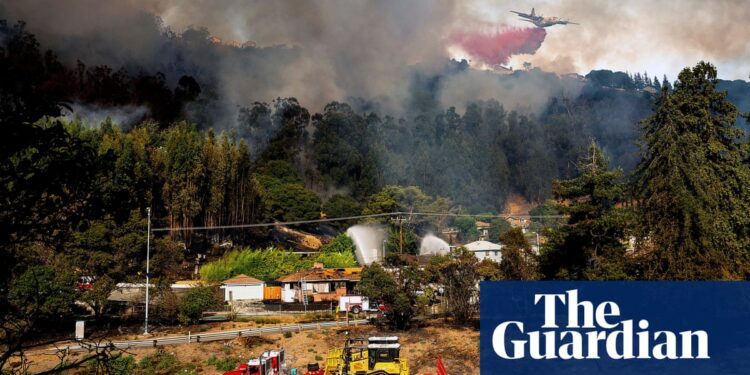A fast-moving brush fire Friday in northern California damaged at least 10 structures in the hills of Oakland, prompting an evacuation order as it grew to 13 acres (4 hectares).
No injuries were immediately reported. Crews were called to the area around 1.30pm for a vegetation fire. In less than 30 minutes, the blaze had grown, requiring more firefighters to race to the scene. By 2.30pm, more than 80 firefighters were working to control the blaze alongside state crews, the Oakland fire department said.
It was unclear whether the structures that burned were homes and how badly they were damaged. The fire was near the 580 freeway, which connects the Bay Area to central California, causing traffic jams as people tried to leave the area and smoke wafted over the city of 440,000 people.
Several aircraft with the California department of forestry and fire protection dropped fire retardant, and state highway officials said they shut down lanes on westbound 580 due to the fire.
Smoke was visible 2-3 miles (3-5km) away. Firetrucks and ambulances struggled to get through the gridlock in the freeway’s westbound lanes, their sirens blasting to get vehicles to move out of the way as they raced toward the blaze. The traffic frustrated some drivers enough that they exited the roadway via on-ramps, while others drove on the freeway’s shoulder. The side streets remained heavily gridlocked as well.
The fire was burning in the Oakland hills where a 1991 fire destroyed nearly 3,000 homes and killed 25 people.
It comes as forecasters issued red-flag warnings for fire danger until Saturday from the central coast through the San Francisco Bay Area and into northern Shasta county, not far from the Oregon border.
About 16,000 customers were without electricity Friday after Pacific Gas and Electric shut off power in 19 counties in the northern and central parts of the state. A major “diablo wind” – notorious in the autumn for its hot, dry gusts – was forecast to cause sustained winds reaching 35mph in many areas, raising the risk of power lines sparking a wildfire. The gusts could top 65mph (104 km/h) along mountaintops, according to the National Weather Service (NWS). The strong winds are expected to last through part of the weekend.
Firefighters expected to evacuate a bigger section of the Oakland hills neighborhood as the blaze spread Friday afternoon, Oakland fire department spokesperson Michael Hunt told the Associated Press.
The fire began as a vegetation fire near the freeway and grew uphill, Hunt said. At least eight structures have already been damaged.
He said “hundreds of residents” were being evacuated, but did not have an exact number.
“It’s a large, probably three-mile area that’s probably potentially evacuated,” he said.
A nearby elementary school was getting set up to serve as a temporary shelter for the evacuees.
A total of about 20,000 customers could lose power temporarily in the next couple of days, PG&E said in a statement Friday.
“The duration and extent of power outages will depend on the weather in each area, and not all customers will be affected for the entire period,” the utility said.
It was not immediately clear what caused the Oakland blaze. The fire department ordered people to evacuate Friday on two streets, Campus Drive and Crystal Ridge Court.
“This could end up being the most significant wind event for this year so far,” said meteorologist Brayden Murdock with the NWS’s Bay Area office. “We want to tell people to be cautious.”
Targeted power shutoffs were also possible in southern California, where another notorious weather phenomenon, the Santa Ana winds, are expected Friday and Saturday.
Santa Anas are dry, warm and gusty north-east winds that blow from the interior of southern California toward the coast and offshore, moving in the opposite direction of the normal onshore flow that carries moist air from the Pacific into the region.
The National Weather Service issued red-flag warnings for the valleys and mountains of Los Angeles county, portions of the Inland Empire, and the San Bernardino mountains.
Winds around greater Los Angeles won’t be as powerful as up north, with gusts from 25-40mph (40-64 km/h) possible in mountains and foothills, said Mike Wofford, a meteorologist with the NWS’s Los Angeles-area office.
The strongest winds were being recorded in the Santa Monica and San Gabriel mountains, where Friday there were gusts from 45-55mph (72-88 km/h) with isolated gusts up to 60mph (96km/h), he said.
“Humidities are drying out and we have the winds. If we had a fire spark, it could really spread quickly because of the current conditions,” Wofford said.







